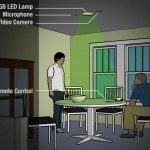Situational Lighting for dining table.
 Dining tables in the home seem to be used for many functions and can be a central hub of activity in small living spaces. Three situations quickly come to my mind: entertaining, working and eating. I propose a situational reactive illumination system for the dining room table.
Dining tables in the home seem to be used for many functions and can be a central hub of activity in small living spaces. Three situations quickly come to my mind: entertaining, working and eating. I propose a situational reactive illumination system for the dining room table.
User scenario
Sit down at the dining room table do some reading work. Select the “Work” lighting preset from a control panel on the table. The illumination on the table becomes a cool while – bright but not overpowering. After 20 minutes the lights subtly pulse to remind you to take a quick stretch break, following a user preference you’ve chosen earlier, then return to their normal level.
When you’ve finished your work it’s time to have a bit to eat. As you sit down with your meal, you select the “Meal” preset and the lights dim slightly, then slowly shift to a green-yellow hue to mimic the salad on the table in front of you. The color of the lights gradually returns to a warm white as the meal is finished.
Later in the evening, a couple of friends come over chat over coffee. You select “Talk” from the lighting menu and the lights take on a bright warm white. As the conversation progresses from joking to heated discussion to resolve and winds down again the hue of the lights slowly respond to the tone of voices in the conversation – from muted yellow to red to green then blue. You finally leave the table for the evening and the illumination returns to a neutral white before fading out as the rest of the room falls dark.
Technical description
A physical control panel accepts user input for enabling the various reactive modes as well as direct control over the illumination levels. An adjustable RGB LED lamp is mounted above the table, either along with or a complete replacement for a traditional lighting fixture. The can be installed in the ceiling, appearing as recessed lighting, provided enough cooling is available for the lamp. A color video camera is also installed above the table and is used to determine the colors of items on the table for use when the illumination is in the “Meal” mode described above. White light will enable the system to establish a baseline histogram at the beginning of the program mode. A microphone will provide sound for software voice stress analysis for the “Talk” mode. An embedded computer system will handle computer vision, audio analysis and will communicate lighting cues to an attached microcontroller for the lamp.
Sensors
Microphone – above the table.
Camera – color, above the table to analyze items for the complementary color mode
RGB LED lamp – above the table to provide illumination. RGB led array?
Remote Control panel – wireless.
Microcontroller / computer – computer vision, voice stress analysis software, drive lamp.
Leave a Reply
You must be logged in to post a comment.